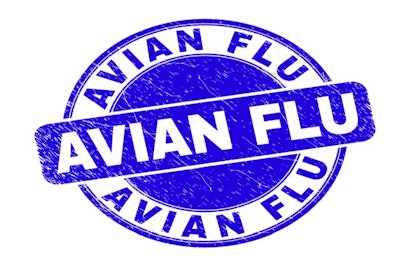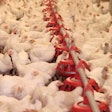
Earlier outbreak series of highly pathogenic avian influenza (HPAI) affecting poultry appear to have been resolved in France and the United Kingdom (U.K.). While the rate of new outbreaks has declined sharply in poultry across Europe in recent months, new cases in poultry have been confirmed in Belgium, Kosovo and Poland.
In northern and western Europe, low numbers of wild birds have tested positive for HPAI viruses, offering a warning for the possible return of the disease with the forthcoming seasonal migrations of wild species.
France declares self free of avian infleunza
In welcome news for the French poultry sector, the agriculture ministry declared the country fee of HPAI at the start of September.
With wild bird migrations the probable source of the infection in November of 2020, the H5N8 virus variant was detected in a total of 492 outbreaks. Cases were confirmed in 15 departments across much of the country. Worst affected was the south-west, where 95% of the outbreaks were confirmed. In this area, there were 64 outbreaks in the department of Pyrénées-Atlantiques, 40 in Landes, and 32 in Gers. Around 3.5 million poultry — mainly ducks in this region — were culled to prevent further spread of the infection, according to the ministry.
More than 2.4 million poultry were directly impacted by the disease through mortality or culling at infected premises. These figures are based on official reports to the World Organisation for Animal Health (OIE). The most recent outbreak was in May of this year in the department of Lower Rhine (Bas-Rhin).
Since the end of August, the national veterinary authority has declared to the OIE that the avian flu situation has also been resolved with respect to other virus types in France. In poultry, this applies to the H5N3 low-pathogenic avian influenza (LPAI) virus. Also concluded are outbreaks in wild birds and backyard flocks linked to the H5, H5N1, and H5N3 virus groups. Latest infection was in a backyard flock in central France with a virus of the H5 family two months ago.
U.K. also free of avian flu
On September 3, the U.K. declared itself free of avian influenza.
The official announcement from the agriculture department, Defra followed a period of time with no outbreaks of the disease. While assessing the current risk of the disease in the country as “low,” the agency stated that H5N8 HPAI virus continues to be detected sporadically in other European countries. Defra says that monitoring of the situation will continue.
Based on reports to the OIE, there were 18 outbreaks of HPAI linked to the H5N8 virus variant in the country’s poultry flocks between November of 2020 and March of this year. In addition, two flocks tested positive for the H5N1 subtype — a backyard flock in December, and in commercial game birds two months later.
Directly impacted by HPAI through mortality and culling of infected flocks were more than 292,000 poultry in the U.K.
Situation balanced in Belgium
At the end of August, authorities in Belgium declared the country free of HPAI under OIE rules.
Since then, the situation regarding H5 HPAI in wild birds and H5 LPAI in poultry has also been declared “resolved” to the OIE.
Detection of the LPAI virus in a single poultry flock in December of 2020 resulted in mortality of around 5,000 birds and culling of a further 73,900. There were 26 outbreaks linked to the H5 HPAI virus in wild and non-commercial birds in Belgium between November of 2020 and early July this year.
In contrast to these positive developments, the H5N8 HPAI virus was detected in a mixed poultry flock at Menen in West Flanders at the end of August. Of the 348 birds — chickens, turkeys, and guinea fowl — 80 died and the rest have been destroyed. These were the first cases in the country since early July.
Poland reports new HPAI outbreak in poultry
Around one month ago, a commercial flock in central-western province of Mazovia tested positive for the H5N8 HPAI virus. Of the 112,000 birds present, around 500 died and rest were destroyed, according to the official report to the OIE.
This outbreak was the first in the country since the end of June. It brought to 339 the number of confirmed outbreaks linked to this virus variant so far in 2021, according to Poland’s chief veterinary office.
Europe’s 2021 HPAI outbreak total in poultry: 1,188
The latest data from the Animal Disease Information System of the European Commission (EC) puts the number of HPAI outbreaks in Europe so far this year at 1,188. This was the total as of September 4.
Nineteen countries have recorded HPAI outbreaks in poultry with the EC so far this year.
For 2021, worst affected has been France with 474 outbreaks, but the situation appears to have been resolved. Poland has now registered 339 outbreaks through this system, while the German total of 209 has remained unchanged for more than two months. These are followed by Lithuania with 39 outbreaks in poultry, and the Czech Republic with 37.
Apart from Poland, the only country to have registered new cases of HPAI in poultry since the start of August is Kosovo. According to the European Reference Lab for avian influenza, IZSVe, there have been 21 confirmed HPAI outbreaks in Kosovo — two on farms and 19 in backyard flocks. In each case, presence of the H5N8 HPAI virus variant was confirmed.
Overall avian flu situation in European wild birds
In contrast to the sharp decline in new cases in poultry, European states continue to register additional wild birds testing positive for HPAI — albeit at a slower rate.
For 2021, the number of confirmed outbreaks of HPAI among wild birds in Europe stands at 1,692, according to the EC’s notification system (as of September 4). A total of 28 states in the region have registered with the EC one or more cases of HPAI in their respective wild bird populations. With its total of 881, Germany has registered by far the most cases. Next come Denmark (241 outbreaks), and Sweden (104).
For comparison, a total of 756 outbreaks of HPAI in wild birds were registered by 13 European nations with the EC system in 2020.
In Switzerland, the situation relating to H5N4 HPAI virus in wild birds appears to be resolved. According to official reports to the OIE, this virus was detected in five birds at two locations in the northern canton of Schaffhausen in February of this year. Monitoring and surveillance in the area have revealed no further cases since that time.
New cases in wild birds in three countries
In the Netherlands, around 1,400 wild birds have tested positive for the H5N8 virus since August 12. Most of these birds belonged to a flock of ornamental water birds in the eastern province of Overijssel. More than 660 of these birds were culled, and 36 poultry farms within a radius of 10 kilometers were being monitored, according to the Dutch agriculture ministry.
Authorities in Finland have reported to the OIE that four more wild birds have tested positive for the H5N1 HPAI virus, and one for the H5N8 variant. In Sweden, two eagle chicks tested positive for the same virus subtype in May, as well as a group of around 20 ducks found dead at the end of August.
View our continuing coverage of the global avian influenza situation.















